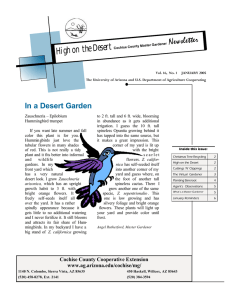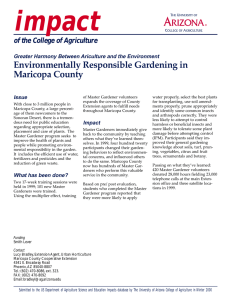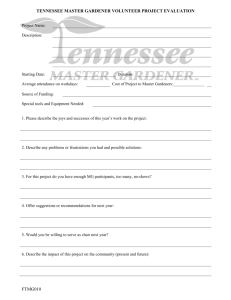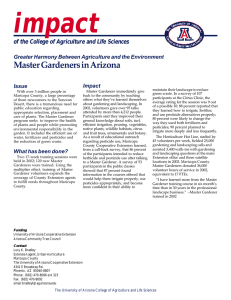Newsletter High on the Desert
advertisement
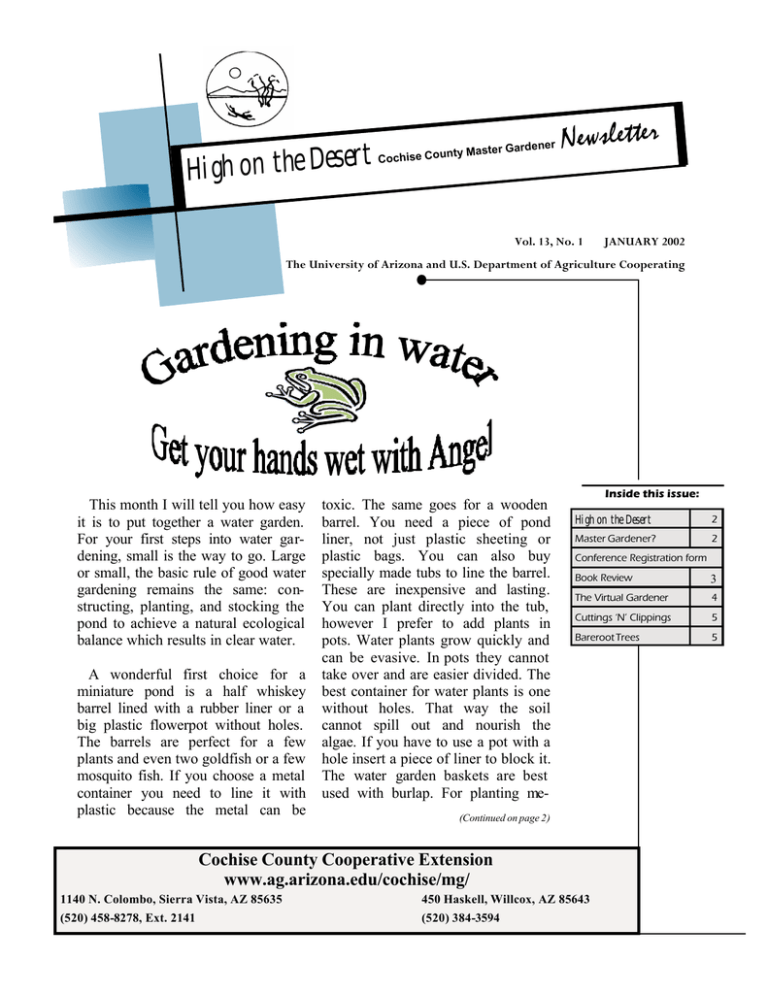
t r e s e D e h t n o h g i H ardener nty Master G Cochise Cou Newsletter Vol. 13, No. 1 JANUARY 2002 The University of Arizona and U.S. Department of Agriculture Cooperating This month I will tell you how easy it is to put together a water garden. For your first steps into water gardening, small is the way to go. Large or small, the basic rule of good water gardening remains the same: constructing, planting, and stocking the pond to achieve a natural ecological balance which results in clear water. A wonderful first choice for a miniature pond is a half whiskey barrel lined with a rubber liner or a big plastic flowerpot without holes. The barrels are perfect for a few plants and even two goldfish or a few mosquito fish. If you choose a metal container you need to line it with plastic because the metal can be toxic. The same goes for a wooden barrel. You need a piece of pond liner, not just plastic sheeting or plastic bags. You can also buy specially made tubs to line the barrel. These are inexpensive and lasting. You can plant directly into the tub, however I prefer to add plants in pots. Water plants grow quickly and can be evasive. In pots they cannot take over and are easier divided. The best container for water plants is one without holes. That way the soil cannot spill out and nourish the algae. If you have to use a pot with a hole insert a piece of liner to block it. The water garden baskets are best used with burlap. For planting me- Inside this issue: High on the Desert 2 Master Gardener? 2 Conference Registration form Book Review 3 The Virtual Gardener 4 Cuttings ‘N’ Clippings 5 Bareroot Trees 5 (Continued on page 2) Cochise County Cooperative Extension www.ag.arizona.edu/cochise/mg/ 1140 N. Colombo, Sierra Vista, AZ 85635 450 Haskell, Willcox, AZ 85643 (520) 458-8278, Ext. 2141 (520) 384-3594 PAGE 2 (Continued from page 1) dium use heavy clay, straight out your yard, sifting out the rocks. Never use potting soil, compost, peat moss, or highly organic soils, all of which may cloud the water and make the algae grow. After planting (as you would any plant), top off with at least an inch of fine sand and then clean pebbles. To fertilize use only specially made water plant tabs or water plant liquid fertilizer. Everything else is toxic to insects and wildlife and will stimulate algae growth. To plant your tub, choose a miniature water lily for the bottom and maybe a bunch of elodea or hornwort. Both of these plants are submerged plants and will clarify the water keeping the algae down as they act as a natural filter. A water iris, canna, or umbrella plant for height will be nice. These are marginal plants and do not like more than one inch of water over their crowns. Stand these pots on bricks. Choose the red ones, never concrete blocks because the lime will leach out and be toxic. To finish your planting, use some floating pla nts like water hyacinth or lettuce. To fill your little pond, use water that has been standing for a day or two or use filtered water. To fill, set a bowl or rock into the tub and pour the water in or onto it so that your plants will not be washed out of their pots. If you want to add fish, wait a few weeks till the pond has balanced out. You may want to add a little pump to aerate the water and for sound. A luft pump and an air stone will High on the Desert The 9th annual High Desert Gardening & Landscaping Conference will be held February 21 & 22, 2002 at the Windemere Hotel & Conference Center in Sierra Vista. You will find a registration form in this month’s newsletter and on our web site. Register early—pre-registration required! We hope to see YOU there! work too. Moving water will hold off mosquitoes. Make weekly water exchanges of 10%; never just fill up what has evaporated. Use this water on your garden. In our climate it is good practice to give your barrel afternoon shade. Voila, you’re in business! Plant of the Month: Umbrella sedge (Cyprus longus) Triangular stems grow 2-4 ft. tall and bear bright green stiffly ribbed leaves radiating from the top like an umbrella. This is an attractive and hardy plant. In very cold winters the umbrellas might get brown but spring will bring plenty more. Propagate by division What is a Master Gardener Anyway? The Master Gardener program began in King and Pierce counties of Washington state in 1972 where an overworked Horticultural Extension Agent, Dr. David Gibby, began training volunteers to assist him in providing support to the community. Dr. Gibby’s program was simple and effective. In exchange for a promise to donate a certain number of hours service, he gave volunteers specialized, university-level training in horticulture. Word of his success in recruiting volunteer support soon spread to other communities, and today Master (Continued on page 4) Angel Rutherford Master Gardener Robert E. Call Extension Agent, Horticulture Carolyn Gruenhagen Editor PAGE 3 Book Review Gaia’s Garden: A Guide to HomeScale Permaculture, by Toby Hemenway ISBN 1-890132-52-7, Chelsea Green Publishing Company, 214 pages I don’t know where to start—this is the best book on permaculture gardening—actually it is the best book on gardening that I have ever read—period! Permaculture, in a nutshell, is observing nature, who is the best landscape designer, and using those principles to create a garden that ecologically supports wildlife, people and Gaia (the earth). What makes this book so different from other permaculture books is that it is scaled for backyard applications and can be implemented by the average homeowner. I already practice many permaculture principles (they merge very well with xeriscape principles). This book will help me along to the next level of creating a garden that works for me, not against me. The book is broken down into three parts. Part One is The Garden as Ecosystem. Topics covered include gardens that really work with Mother Nature instead of against her, why our current gardening principles cause us so much work and disappointment, the native plant vs. exotic plant debate, a few of nature’s tricks for gardeners, and natural patterns and the landscape design process. Part Two covers The Pieces of the Ecological Garden to include how to bring your soil to life and how soil works. Written from the point of view of the soil—I learned some very interesting stuff on dirt! One of the most interestin g topics in this book is the chapter on catching, conserving, and using water. This section has a very interesting greywater system that I plan to start working on this summer. Again the author takes the point of view to tell a story, in this case of a tree, to show us how important trees are to us and the many roles they play. And finally he brings in the important role of inviting bees, birds, and other helpful animals to the garden. Part Three is the Assembling the Ecological Garden which shows us how to create plant communities, design garden guilds, and grow a food forest. Also included is a list of useful plants and glossary. The resource section is an excellent compilation of magazines, organizations, plant databases on the internet, seeds, plants, ,and supplies. Thanks to the generosity of the Sierra Vista Area Gardeners Club this book is available from the Sierra Vista Library. The club recently donated this book along with 13 other gardening books to the library—check it out! Cheri Melton Master Gardener January Reminders Winter pruning Remove old mulch & replace Dig tree holes Prepare soil for spring Water periodically Stratify seeds Fertilize asparagus General garden clean-up High on the Desert The Cochise County Master Gardeners Association (CCMGA) is awarding up to five full scholarships to the 2002 High Desert Gardening & Landscaping Conference to be held at the Windemere Hotel & Conference Center February 21 & 22. Applicants are invited to submit an essay on one of the following topics: • Gardening for food production • Landscaping with native plants • Environmental stewardship Essays must meet the following criteria: 1. 750 to 1,000 words in length. 2. Double spaced and typed on plain bond paper. 3. Represent original schola rship and be suitable for publication. All references and authorities cited must be properly attributed. 4. Entries must be accompanied by an official cover sheet obtainable from the Cooperative Extension Office at the U of A South campus. 5. Entries must be received at the Cooperative Extension Office at the U of A South campus not later than close of business on January 15, 2002. Entries will be judged by the Cochise County Horticultural Extension Agent and a committee of Master Gardeners appointed by the President of CCMGA. Winners will be notified by the end of January and the names of awardees will be announced in the February 2002 Master Gardener newsletter. PAGE 4 The Virtual Gardener — W i l d f l o w e r s Lady Bird Johnson, now 89 years old, has been an active environmentalist all of her life. While First Lady she began a program to beautify the nation’s capital city and then expanded her program to encompass the whole nation. In 1982 she founded the Lady Bird Johnson Wildflower Center in Austin, Texas to educate people about the value of native plants and promote their wider use in landscaping. The Web pages of the Wildflower Center include a virtual tour of the Center and other topics that you would expect to find at such a Web site. What I am most excited about, though, are the native plant information pages beginning at http://wildflower.avatartech. com/Plants_Online/ Native_Plants/native.html. Here you will find the portal into a vast array of native plant information which is not just limited to wildflowers. This page allows you to view many lists of plants. Lists are sorted by either scientific or common names for either the entire country or a selected state; lists of plants in a selected plant family; and lists of plants by type (annual flower, biennial flower, perennial flower, etc.) Each entry in a list is a link to photos and detailed information about a plant. You can also search directly for information about a specific plant by entering either its scientific or common name in a text box. Once you have selected a specific plant, you are presented with a wealth of practical information about it. For example, here is some of the information presented about one of my favorite locally native plants, the Fairy Duster: • Scientific name: Calliandra eriophylla • Family: Fabaceae • Description: Fairy-duster is a straggling, densely branched, deciduous shrub to 3 ft., though usually much shorter, with grayish-pubescent leaflets, flowers and pods. The petals of fairy duster are inconspicuous; it is the long, pink filaments of the stamens that make the showy display. • Bloom Period: FebruaryMay • Flower Color: Pink • Site Preference: Dry gravelly slopes and mesas • Sun Exposure: Full sun • Wildlife Value: Highly palatable to deer. The flowers attract butterflies and quail eat its seeds. • Propagation: Seed coats are hard and require a hot-water treatment for germination. Sow seeds when soil is warm. • Comments: Though slowgrowing, fairy duster is valuable as erosion control. It is extremely droughttolerant and somewhat resistant to browsing. Tipprune to increase density. In addition to plant information, you can also call up lists of landscapers who specialize in native plants, sources of native plant materials, and organizations that specialize in native plants. The only landscapers listed for Arizona are in Phoenix or Tucson, but a local grower/harvester familiar to all who attend the High Desert Landscaping & Gardening Conference is listed for Cochise County—Spadefoot Nursery Until next surfing! month, happy Gary A. Gruenhagen, Master Gardener gruenha@sinosa.com (Continued from page 2) Gardener programs are flourishing throughout the United States and Canada. The Master Gardener program was started in Cochise County in 1987 by County Horticultural Extension Agent, Dr. Deborah Young. The current agent, Rob Call, has continued the program, teaching the thirteen week course at least once a year. Prospective Master Gardeners who take the course study such topics as soils, pest management, bota ny, gardening, landscaping, and environmental stewardship. The University of Arizona Extension Offices are located in Willcox and Sierra Vista and you may reach a Master Gardener to assist you with your questions about gardening by calling the numbers listed on the front page of the newsletter. There is no charge for this gardening service—it is all part of the U of A’s commitment to excellence and the people they serve. For more information on the Master Gardener program, please call 458-8278, Ext. 2141. PAGE 5 Cuttings ‘N’ Clippings T The next regular meeting of Cochise County Master Gardeners is March 6, 2002. The time and location will be announced at a later date. T The February 2, 2002 Water Wise workshop is: Pruning Landscape Trees from 9 am-10:30 am with DeForest Lewis, Certified Arborist and Cochise County Master Gardener. The free workshop takes place at the S.V. Police Station, 911 N. Coronado, Sierra Vista. T Cochise College is offering Home Gardening AGR 215 beginning January 15, 2002 and running for 16 weeks from 5:00—8:00 p.m. The class will cover the care and maintenance of trees, hedges, shrubs, and flowers as well as cultivation of vegetable gardens. For more information or to register call (520) 515-0500. Planting and Caring for Bareroot Trees and Shrubs During Southeast Arizona’s winter season, local nurseries will be offering bareroot trees and shrubs for sale. For the price conscious consumer, bareroot trees and bushes are an economical way to acquire additional plants. Some plants and certain varieties will only be available in bareroot form. With proper care and handling, the gardener can be just as successful with bareroot as with containerized stock. And one can be assured when buying bareroot plants that you will never have to deal with a root bound plant! When purchasing bareroot stock, inspect the plants carefully. Bareroot plants can never, ever be allowed to dry out. This includes all the time from when they were initially removed from the soil at the grower until you, the consumer, plants them once more. Never purchase plants whose roots do not look plump and moist. The retailer should have taken the time to carefully prune any damaged roots and stored them in a moist medium. If it looks like this was not done, keep on a walking—because this could very well indicate possible other problems with their handling of the bareroot stock. One should also check the trunk and branches for signs of dessication. Most bareroot stock that you see in retail centers will be severely pruned. There is considerable debate about the efficacy of this within the industry. My personal experience has shown that it doesn’t make much of a difference when the plants are properly planted and cared for except with certain persnickedy plants like pecans. Pecans should come with as much of the tap root intact as possible (this means you will be digging to China to plant them). Here in SE Arizona, I believe that pecans are a 50/50 proposition in bareroot with a great many variables weighing heavily against success for the home grower. I would buy containerized stock if possible. But due to scarcity of local sources, you just might have to gamble and give bareroot a shot. I recommend that you have holes dug in anticipation of your purchase. The sooner you get your bareroot trees into the ground the better. If you are unable to plant immediately, put them in a shady area and cover their roots with a moist medium. I generally soak the roots in a mixture of “superthrive” (or similar product) and water for an hour or so before planting. The planting hole should be adequate to fully accommodate the plant’s root structure. It is always advisable to dig wider than deeper. A hole 16" by 24" is generally adequate. Always (Continued on back page) Issued in furtherance of Cooperative Extension work, acts of May 8 and June 30, 1914, in cooperation with the United States Department of Agriculture, James A. Christenson, Director, Cooperative Extension, College of Agriculture and Life Sciences, The Univ ersity of Arizona and Arizona Counties cooperating. The University of Arizona College of Agriculture and Life Sciences is an equal opportunity employer authorized to provide research, educational information and other services only to individuals and institutions that function without regard to sex, race, religion, color, national origin, age, Vietnam Era Veteran’s status, or disability. The information given herein is supplied with the understanding that no discrimination is intended and no endorsement by Cooperative Extension is implied. Any products, services, or organizations that are mentioned, shown, or indirectly implied in this publication do not imply endorsement by the University of ARIZONA COOPERATIVE EXTENSION U.S. DEPARTMENT OF AGRICULTURE Cochise County 450 S. Haskell Avenue Willcox, AZ 85643-2790 OFFICIA L BUSINESS PENALTY FOR PRIVATE USE $300 PRSRT STD POSTAGE & FEES PAID USDA PERMIT NO. G268 Return Service Requested (Continued from page 5) check the planting hole for proper drainage before planting. Once dug, fill the hole with water to the brim twice. Drainage of 3" an hour is acceptable but 6" per hour is better. If the hole is not draining well, you must do whatever is necessary to provide adequate drainage. That could involve digging deeper, providing drainage holes through the compacted barrier, and/or adding gypsum to the planting mix (see previous newsletter articles or contact MG office for specific guidance). Save the dirt from the planting hole. Mix a small amount of compost and a handful of soil sulfur into this dirt. Take some of this backfill mix to make a small mound in the hole over which the plant's roots will rest. WARNING! Make sure that you do not plant too deep. Examine the bark below the graft carefully and plant at the same depth as the plant was originally. I guarantee that your plant WILL DIE if planted too deep. Drive a stake (use wood—much easier to remove once no longer needed) into the hole to secure the plant. You do not want the plant’s delicate new roots to be disturbed by high wind Fill in the hole with your back fill mix; water in thoroughly. Use excess soil for a watering berm around the plant. Be careful not to overwater! Deciduous plants use very little water during dormancy. Water just enough to maintain the soil moist (not wet). Once the plant starts to leaf out, increase watering amount and frequency. In addition, once the plant leafs out, be prepared to protect from late freezes. Bareroot plants seldom have enough stored energy to leaf out more than once or twice. Bareroot roses need a little more attention. The canes must stay moist to ensure budding. The growers recommend frequent misting. I usually allow only 2 weeks after planting for the roses to show budding on the canes (increase this time if it has been consistently cold). If not, I go into emergency mode and surround the new roses with an old nursery container (bottom cut out) or box that I fill with damp wood shavings. Cover the canes completely. Every few days, gently dig into the shavings. Remove the shavings at the first sign of budding. (I have never lost a rose when following this procedure). Again protect newly leafed out roses from late freezes. John Phillips Master Gardener


